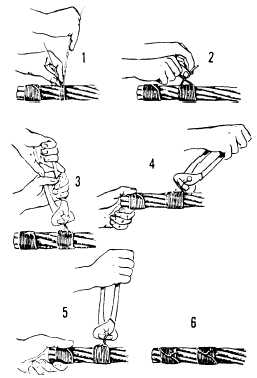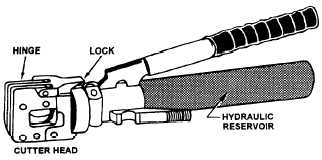ordinarily used and should be spaced as far apart as
possible.
Seizing and Cutting
The makers of wire rope are careful to lay each wire
in the strand and each strand in the rope under uniform
tension. If the ends of the rope are not secured properly,
the original balance of tension will be disturbed and
maximum service cannot be obtained because some
strands can carry a greater portion of the load than
others. Before cutting steel wire rope, place seizing on
each side of the point where the rope is to be cut
(fig. 13-18).
A rule of thumb for determining the size, number,
and distance between seizing is as follows:
1. The number of seizing to be applied equals
approximately three times the diameter of the rope.
Example: 3 x 3/4-inch-diameter rope = 2 1/4 inches.
Round up to the next higher whole number and use three
seizing.
2. The width of each seizing should be 1 to 1 1/2
times as long as the diameter of the rope.
Example: 1 x 3/4-inch-diameter rope = 3/4 inch.
Use a 1-inch width of seizing.
Figure 13-18.-Seizing wire rope.
3. The seizing should be spaced a distance equal to
twice the diameter of the wire rope.
Example: 2 x 3/4-inch-diameter rope = 1 1/2 inches.
Space the seizing 2 inches apart.
A common method used to make a temporary wire
rope seizing is as follows:
Wind on the seizing wire uniformly, using tension
on the wire. After taking the required number of turns,
as shown in step 1, twist the ends of the wires
counterclockwise by hand, so the twisted portion of the
wires is near the middle of the seizing, as shown in
step 2. Grasp the ends with end-cutting nippers and twist
up slack, as shown in step 3. Do not try to tighten the
seizing by twisting. Draw up on the seizing, as shown
in step 4. Again twist up the slack, using nippers, as
shown in step 5. Repeat steps 4 and 5 if necessary. Cut
ends and pound them down on the rope, as shown in
step 6. If the seizing is to be permanent or if the rope is
1 5/8 inches or more in diameter, use a serving bar, or
iron, to increase tension on the seizing wire when
putting on the turns.
Wire rope can be cut successfully by a number of
methods. One effective and simple method is to use a
hydraulic type of wire rope cutter, as shown in
figure 13-19. Remember that all wire should be seized
before it is cut. For best results in using this method,
place the rope in the cutter so the blade comes between
the two central seizings. With the release valve closed,
jack the blade against the rope at the location of the cut
and continue to operate the cutter until the wire rope is
cut.
MAINTENANCE OF WIRE ROPE
Wire rope bending around hoist drums and sheaves
will wear like any other metal article, so lubrication is
just as important to an operating wire rope as it is to any
other piece of working machinery. For a wire rope to
Figure 13-19.—Hydraulic type of wire rope cutter.
13-9




